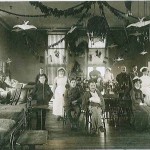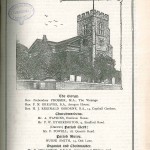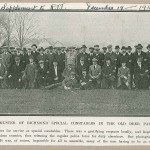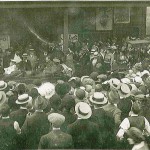Follow the drum: Christmas 1914

The latest post from our Follow the drum series looks at life in Richmond Upon Thames during Christmas 1914.
Unemployment
Preparing for Christmas in 1914 on the home front started to involve domestic economies, as what had been referred to as ‘the European Crisis’ (Twickenham Urban District Council Minutes 1914) showed no signs of lessening. Every indication in fact was that this conflict in reality was becoming a war of deepening gravity. It was not going to be over by Christmas. For example, the local newspaper continued its recruitment campaign by publishing the names of those who had joined the armed forces but the reality of mounting loss of life in large numbers was also evident in the number of obituaries and notices published about local young men who had been killed in action.
The Relief Committee reported that although civil applications for relief for men numbered 26, there were 50 for women. Assistance was granted in 38 cases. At this stage the Fund had been in existence for 3 months. According to the Rev. Max Binney (Chairman of the Committee and the Vicar for Richmond Parish) the support of the Committee of Organised Women was invaluable: ‘…he was glad that the assistance which the committee was giving to unemployed women took the form of wages for work done’. He felt that: ‘… it was a matter for congratulations that the amount of distress in the town due to the war was very slight. It was perhaps considerable among the women…’ (p 9 Richmond Herald 5th December 1914). However one committee member, Mr Copland, pointed out that many men would not apply to the committee for assistance due to the enquiries that were made into their circumstances: ‘… as the cost of living had gone up some of these had great difficulties in making ends meet’. (p 9 Richmond Herald 5th December 1914).
Lady Yoxall emphasised the concern to prevent unemployment amongst women and the coordinated efforts to find them work. ‘It has been difficult to find work which takes much labour and cheap materials. Army shirts were first asked for…and we have tried to develop other lines…needing no material such as domestic help for mothers at the time of childbirth… attending old or infirm people’. (p 9 Richmond Herald 5th December 1914). A proportion of what a woman received in payment depended on the value of the work done, with the rest being relief. The Committee concentrated on domestic service, employment in small businesses, dressmaking and housekeeping all as employment opportunities for women. However, due to the war the new opportunities for women would occur as they replaced men in the workplace and sought better pay and conditions, for example as shop assistants.
The Soldiers and Sailors Families Association was also opening local branches at this time and it was responsible for distributing a weekly sum of 3s 6d to the wives of men in the Forces. This allowance was subject to scrutiny particularly in cases where the wife received a superannuation amount from her husband’s employer. It appeared that the 3s 6d was given to cases where it was justified (The Mayor of Richmond & Mr Denny Cooke, Richmond Herald 5th December 1914).
Christmas presents with international connections
International links came to the fore as the Relief Committee received a letter about the distribution of Christmas presents from the children of the United States to the children of Britain. A brief item also appeared in the Richmond Herald in French headed: ‘La Saint Nicolas dans le district de Richmond’ and aimed at brightening the first Christmas of the war for the Belgian children of refugees now residing in the Borough. The group responsible for this was known ‘L’international Service Volunteers créé par les dames de Richmond et environs…’ and had no inhibitions about using French. Their main objective was to ensure that the Belgian children would not be denied a Christmas celebration. (p 9 Richmond Herald 5th December 1914).
The focus on children at Christmas time was maintained across the Borough and is reflected in the Parish Magazine for St Mary’s Church Twickenham. Here, the special League Entertainment postponed by the declaration of war in August was held in November of 1914 and the Parish had already supported 300 Twickenham children through a variety of appeals since the outbreak of hostilities. They were actively assisting 12 orphaned children of soldiers or sailors as the Ministering League undertook to receive them. The annual treat to the poor children of Twickenham was held on 10th December at 5.30 pm in the Town Hall. (St Mary’s Church, Twickenham Parish Magazine, November 1914). By December 1914 the Infants Sunday School had received presents for the children and they organised a viewing of the gifts for all the ‘kind friends’ who had made these donations (held at Neville House on 17th December from 3 – 6 pm. The Belgian children in want were not forgotten in Twickenham either and the parish Sunday School raised 15s 6d from a collection taken at their Children’s Service on 20th December 1914 (Twickenham Parish Magazine, January 1915).
Mary’s Church Twickenham. Here, the special League Entertainment postponed by the declaration of war in August was held in November of 1914 and the Parish had already supported 300 Twickenham children through a variety of appeals since the outbreak of hostilities. They were actively assisting 12 orphaned children of soldiers or sailors as the Ministering League undertook to receive them. The annual treat to the poor children of Twickenham was held on 10th December at 5.30 pm in the Town Hall. (St Mary’s Church, Twickenham Parish Magazine, November 1914). By December 1914 the Infants Sunday School had received presents for the children and they organised a viewing of the gifts for all the ‘kind friends’ who had made these donations (held at Neville House on 17th December from 3 – 6 pm. The Belgian children in want were not forgotten in Twickenham either and the parish Sunday School raised 15s 6d from a collection taken at their Children’s Service on 20th December 1914 (Twickenham Parish Magazine, January 1915).
On-going losses
Heartfelt messages of deep sympathy continued in Twickenham Parish Magazine alongside these notices as the Parish Roll of Honour lengthened. The additions for December 1914 were: Sydney Barnard, 9th Lancers; Charles Price, Royal navy; Leonard Beck, Royal Navy and Ivor Davies, Royal Fusiliers. (Twickenham Parish Magazine, December 1914). A Day of Prayer for the War was publicised, requested by the Archbishops of Canterbury and York for the first Sunday of the New Year (3rd January 1915). Aside from the patriotic sentiments expressed about this event the prayers were being said on behalf of the men who were fighting on sea and land. Many households would be lacking family members over Christmas either due to bereavement or due to their military service in the conflict. The newsletter reflects on Christmas 1914 in muted tones: ‘This year we have spent a very quite Christmas. It was nothing more than could be expected when so many who are so near and dear to use are away in the midst of peril and death’ (Twickenham Parish Magazine, January 1915).
Plum pudding and gifts
Attempts to normalise Christmas on the home-front were made such as publishing the recipe for plum pudding for those at home to carry on with ordinary family preparations for the festival in good time for Christmas Day (Richmond Herald, p 13 28th November 1914). It had become a regular feature of daily life to consider sending home comforts to the soldiers at the front (for example, contributing to tobacco funds for the East Surreys; sending blankets; knitting warm clothing items or making/repairing clothing; sending hampers of food). At this time, cards and presents were being planned and despatched to troops and also it was reported that gifts could be sent to prisoners of war as well (Richmond Herald, p 14 28th November 1914). From time to time details of men in that situation were announced in an effort to provide some home contact for them. Also troops on the front line were receiving a special gift from Queen Mary for Christmas 1914 (the commemorative tin with chocolate and tobacco inside). The emphasis was on maintaining personal contact and boosting morale wherever possible.
After 3 months of war, a report of a soldier’ overstaying his leave also appeared (James Harris, aged 50, from Douglas Road, St Margarets. Richmond Herald p 13, 28th November 1914). He was being pursued through the courts to ensure a return to duty. It was not uncommon to read about other men who deserted or went ‘absent without leave’ (Richmond Herald November and December 1914). We are able to use hindsight to wonder at what the reasons might have been (after 12 weeks of this brutal war it was to some extent inevitable that this would occur for a variety of reasons such as being home-sick at Christmas, age or maybe psychological reasons).
Doing your bit
Meanwhile, the local population as a whole from every walk of life and age group continued to be active in stepping  forward to ‘do their bit’. Two examples of this occurred on the same day in 1914: 19th December 1914. In terms of civil defence and home-front security those men that did not meet recruitment criteria came forward to serve. as Special Constables. By December 1914, the Richmond Special Constables held a ‘muster’ in Old Deer Park, as can be seen in the commemorative photograph. These local men would be used to release the existing Police for urgent duty elsewhere. Not all of the men were in fact able to make this picture due to having to be on duty at that time. All ages were included on the home-front and the young girls of the district were also encouraged to join the Girl Guides (Richmond) as their patriotic responsibility. Included in their training would be drills and parades involving saluting the flag. This was also another way of supporting family members who were fighting the war.
forward to ‘do their bit’. Two examples of this occurred on the same day in 1914: 19th December 1914. In terms of civil defence and home-front security those men that did not meet recruitment criteria came forward to serve. as Special Constables. By December 1914, the Richmond Special Constables held a ‘muster’ in Old Deer Park, as can be seen in the commemorative photograph. These local men would be used to release the existing Police for urgent duty elsewhere. Not all of the men were in fact able to make this picture due to having to be on duty at that time. All ages were included on the home-front and the young girls of the district were also encouraged to join the Girl Guides (Richmond) as their patriotic responsibility. Included in their training would be drills and parades involving saluting the flag. This was also another way of supporting family members who were fighting the war.
Wounded soldiers
Finally, the first wounded had by this time returned, arriving back in the local area through Richmond Station. Hospital wards were decorated to give a flavour of home for any men in hospital over the Christmas period. Boosting morale was a key part of their hospital experience.
wards were decorated to give a flavour of home for any men in hospital over the Christmas period. Boosting morale was a key part of their hospital experience.
For more information about life in Richmond Upon Thames visit our Local Studies department
Images: Royal Hospital Christmas 1914.LCF 4212;Special Constables Muster.1914_oversize Old Deer Pk; Royal Hospital Christmas 1914.LCF 4212/13; Twickenham Parish Magazine cover page Dec. 1914; First wounded arriving back in Richmond 1914.
